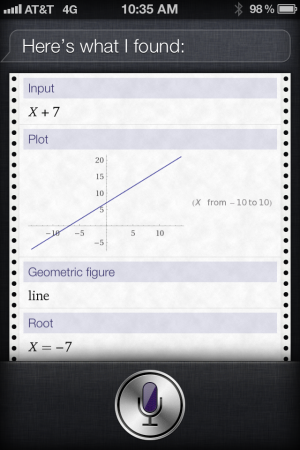Short of banning smartphones (a short-term solution, at best), the evolution of artificial intelligence services like Siri means that there will be a shift from a focus on finding the answer as the endpoint to a greater focus on analysis. You have the answer, but so what? What does that answer mean in a real-life situation?
Should teachers just take the bit that they have traditionally needed for this kind of problem or should they figure out how to use this extra information provided by Siri to push students' thinking beyond where it usually goes with eighth graders?
Taking digital tools and mobile technologies into account (not to mention Common Core expectations), it’s obvious that multiple-choice and true-false questions are not going to cut it anymore. Instead, educators have to design questions that force students into drawing conclusions and using the proof process that many of them haven’t encountered yet.
One method of practicing problem-solving is giving students both the question and the answer and asking them to explain how to solve the problem — how you harvest the information from the problem and show the steps in the solution.
Here’s an example: Instead of reviewing the commutative and distributive properties with a worksheet where they would be able to enter the equation into Siri and get the answer, you ask the question in a different way. You can ask them… "Is 5(5x+7) = 25x+7 always, sometimes or never true?” Or you might ask “Is 3x-9 = 9-3x always, sometimes or never true?”
In the first example, they simply have to answer the question and Siri can help them find the answer pretty quickly. In the second example, students have to test out their idea with different kinds of numbers; positive, negative, fractions, improper, zero and big numbers. They search for an example that proves the equation true, or they search for a counter-example that proves what they conjecture to be false.
BALANCING ACT
Changing instruction in this way is a balancing act. Lessons are now designed with the assumption that students will use readily available technology, and build on prior knowledge so the learning will stick.
For example, when we study parallel and perpendicular lines, the objective is for students to learn how the coefficients of these lines are the same and how they are different. It’s easy to give them a definition to memorize, but will they remember it? Connecting the idea to something tangible that they’ve done will ensure that they will.
Many students already have free graphing calculator apps on their phones and use it regularly. They even send screenshots to show what they’re thinking or where they're stuck on a problem. In this case, the app is used just as pencil, notebooks, and graph paper.
IMPLICATIONS FOR OTHER SUBJECTS
Siri is helping students in other classes too. She’s very capable of finding the capitol of a state, the 22nd president of the USA, and who wrote the phrase “Four score and seven years ago.” She knows the plot of every book in the Google Library and won’t hesitate to define “iambic pentameter.” Chemical symbols? Physical laws? A snap.
I wonder how other teachers might have to rethink their teaching and assessment strategies — with Siri and her A.I. colleagues at our students’ beck and call?
Marsha Ratzel is a National Board-certified teacher in the Blue Valley School District in Kansas, where she teaches middle school math, science, and sometimes social studies. A version of this post originally appeared on Voices from the Learning Revolution.
 By Marsha Ratzel
By Marsha Ratzel
